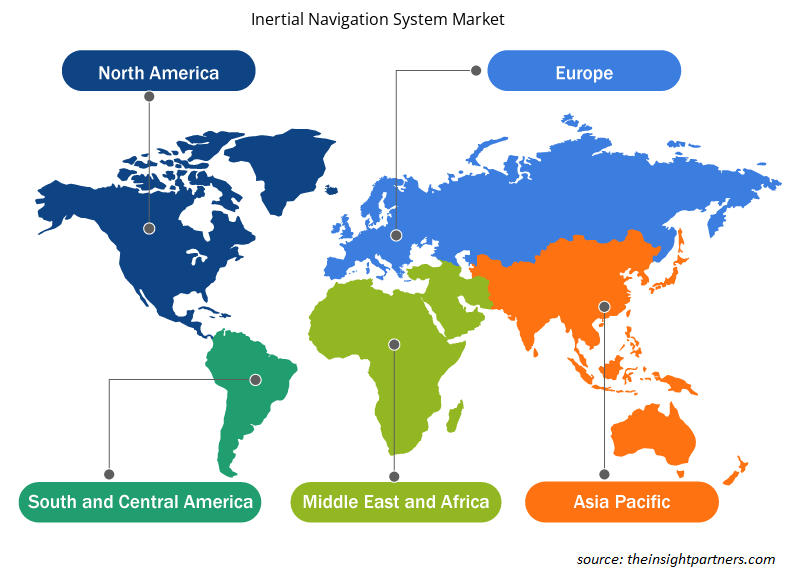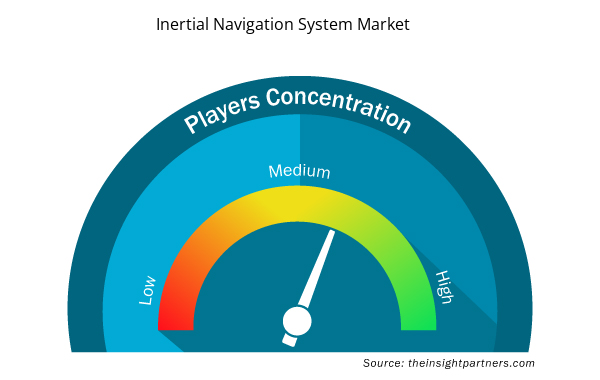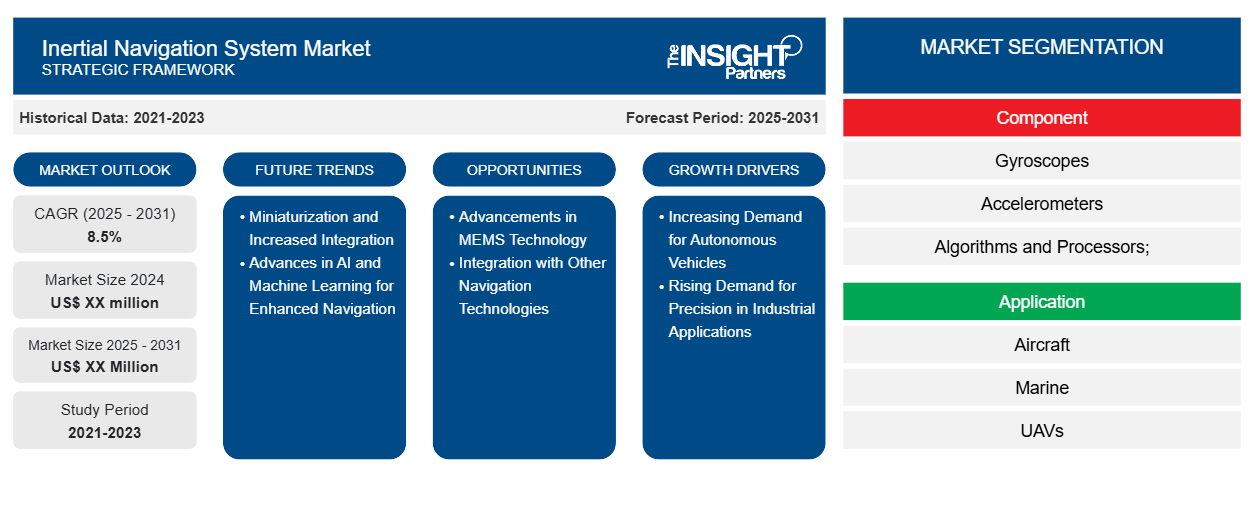Der Markt für Trägheitsnavigationssysteme wird voraussichtlich von 2023 bis 2031 eine durchschnittliche jährliche Wachstumsrate (CAGR) von 8,5 % verzeichnen, wobei die Marktgröße von XX Millionen US-Dollar im Jahr 2023 auf XX Millionen US-Dollar im Jahr 2031 wachsen wird.
Der Markt für Trägheitsnavigationssysteme umfasst Analysen nach Komponenten (Gyroskope, Beschleunigungsmesser, Algorithmen und Prozessoren), Anwendungen (Flugzeuge, Schiffe, UAVs, Sonstige), Technologien (Mechanischer Gyroskop, MEMS, Glasfaser-Gyroskop, Sonstige) und Geografie (Nordamerika, Europa, Asien-Pazifik, Naher Osten und Afrika sowie Süd- und Mittelamerika).
Zweck des Berichts
Der Bericht „Markt für Trägheitsnavigationssysteme“ von The Insight Partners zielt darauf ab, die aktuelle Situation und das zukünftige Wachstum sowie die wichtigsten Antriebsfaktoren, Herausforderungen und Chancen zu beschreiben. Dies wird verschiedenen Geschäftspartnern Einblicke geben, wie zum Beispiel:
- Technologieanbieter/-hersteller: Um die sich entwickelnde Marktdynamik zu verstehen und die potenziellen Wachstumschancen zu kennen, damit sie fundierte strategische Entscheidungen treffen können.
- Investoren: Durchführung einer umfassenden Trendanalyse hinsichtlich der Marktwachstumsrate, der finanziellen Marktprognosen und der Chancen entlang der Wertschöpfungskette.
- Regulierungsbehörden: Zur Regulierung von Richtlinien und Überwachungsaktivitäten auf dem Markt mit dem Ziel, Missbrauch zu minimieren, das Vertrauen der Anleger zu bewahren und die Integrität und Stabilität des Marktes aufrechtzuerhalten.
Marktsegmentierung für Trägheitsnavigationssysteme
Komponente
- Gyroskope
- Beschleunigungsmesser
- Algorithmen und Prozessoren;
Anwendung
- Flugzeug
- Marine
- Drohnen
- Andere;
Technologie
- Mechanischer Kreisel
- MEMS
- Glasfaser-Gyroskop
- Sonstiges
Geographie
- Nordamerika
- Europa
- Asien-Pazifik
- Süd- und Mittelamerika
- Naher Osten und Afrika
Geographie
- Nordamerika
- Europa
- Asien-Pazifik
- Süd- und Mittelamerika
- Naher Osten und Afrika
Passen Sie diesen Bericht Ihren Anforderungen an
Sie erhalten kostenlos individuelle Anpassungen an jedem Bericht, einschließlich Teilen dieses Berichts oder einer Analyse auf Länderebene, eines Excel-Datenpakets sowie tolle Angebote und Rabatte für Start-ups und Universitäten.
- Holen Sie sich die wichtigsten Markttrends aus diesem Bericht.Dieses KOSTENLOSE Beispiel umfasst eine Datenanalyse von Markttrends bis hin zu Schätzungen und Prognosen.
Wachstumstreiber auf dem Markt für Trägheitsnavigationssysteme
- Steigende Nachfrage nach autonomen Fahrzeugen: Einer der Haupttreiber des Marktes für Trägheitsnavigationssysteme (INS) ist die wachsende Nachfrage nach autonomen Fahrzeugen, darunter Drohnen, unbemannte Luftfahrzeuge (UAVs) und autonome Bodenfahrzeuge. Die INS-Technologie ist für diese Systeme von entscheidender Bedeutung, da sie genaue Positions-, Geschwindigkeits- und Orientierungsdaten liefert, ohne dass externe Signale wie GPS erforderlich sind. Da autonome Fahrzeuge in Sektoren wie Transport, Logistik und Verteidigung immer mehr Verbreitung finden, wird der Bedarf an leistungsstarken INS-Systemen, die in Umgebungen ohne GPS funktionieren, voraussichtlich erheblich steigen.
- Steigende Nachfrage nach Präzision in industriellen Anwendungen: Der Bedarf an hoher Präzision in industriellen Anwendungen wie Robotik, Vermessung und geophysikalischer Erkundung treibt die Einführung von Trägheitsnavigationssystemen voran. In Branchen wie Bergbau, Öl und Gas sowie Bauwesen ist die genaue Verfolgung von Ausrüstung und Personal von entscheidender Bedeutung. INS können präzise Daten zur Positionierung und Bewegung von Ausrüstung liefern und so Sicherheit und Effizienz in diesen Hochrisikoumgebungen gewährleisten. Da diese Branchen weiter wachsen und ausgefeiltere Navigationssysteme benötigen, wird die Nachfrage nach INS-Lösungen steigen.
Markttrends für Trägheitsnavigationssysteme
- Miniaturisierung und verstärkte Integration: Ein wichtiger Trend auf dem Markt für Trägheitsnavigationssysteme ist die Miniaturisierung von Sensoren und die verstärkte Integration von INS-Komponenten. Da die Nachfrage nach kleineren, leichteren und kostengünstigeren Navigationssystemen steigt, bewegt sich die Branche in Richtung der Entwicklung hochintegrierter Systeme, die mehrere Sensoren und Komponenten in einem einzigen Paket vereinen. Diese Miniaturisierung wird Branchen wie der Unterhaltungselektronik zugutekommen, wo Platz- und Gewichtsbeschränkungen kritisch sind, sowie neuen Anwendungen im Markt für IoT und tragbare Geräte. Der Trend zu kleineren, leistungsstärkeren Systemen wird auch das Wachstum in anderen Branchen wie der Medizintechnik und der tragbaren Robotik vorantreiben.
- Fortschritte bei KI und maschinellem Lernen für verbesserte Navigation: Die Anwendung künstlicher Intelligenz (KI) und maschinellen Lernens (ML) auf Trägheitsnavigationssysteme ist ein neuer Trend. KI- und ML-Algorithmen können verwendet werden, um die Genauigkeit und Zuverlässigkeit von INS zu verbessern, indem große Datenmengen in Echtzeit verarbeitet, Fehler korrigiert und die Leistung in anspruchsvollen Umgebungen verbessert werden. Beispielsweise können KI und ML in autonomen Fahrzeugen und Drohnen dabei helfen, Änderungen in der Umgebung wie Hindernisse oder Geländeänderungen vorherzusagen und anzupassen, wodurch die Navigation selbst bei fehlendem GPS oder dynamischen Bedingungen verbessert wird. Die Konvergenz von KI mit INS-Technologie wird die Fähigkeiten von Navigationssystemen in verschiedenen Branchen erheblich verbessern.
Marktchancen für Trägheitsnavigationssysteme
- Fortschritte in der MEMS-Technologie: Die Technologie der mikroelektromechanischen Systeme (MEMS) hat die Entwicklung kleinerer, leichterer und kostengünstigerer Trägheitssensoren erheblich vorangetrieben. MEMS-basierte Trägheitsnavigationssysteme erfreuen sich aufgrund ihrer geringeren Kosten, ihrer kompakten Größe und ihrer Fähigkeit, in einer Vielzahl von Anwendungen zuverlässige Leistung zu liefern, zunehmender Beliebtheit. Dies bietet dem INS-Markt die Möglichkeit, sich auf den Verbraucher- und Handelssektor auszudehnen, einschließlich Smartphones, tragbarer Geräte und persönlicher Navigationssysteme. Die Entwicklung MEMS-basierter Systeme eröffnet neue Märkte, insbesondere für Branchen, die kompakte und kostengünstige Navigationslösungen benötigen.
- Integration mit anderen Navigationstechnologien: Die Zukunft von Trägheitsnavigationssystemen liegt in ihrer Integration mit anderen Navigationstechnologien wie GPS, visueller Odometrie und SLAM (Simultaneous Localization and Mapping). Durch die Kombination von INS mit diesen Technologien können Systeme eine höhere Genauigkeit, Zuverlässigkeit und Belastbarkeit in komplexen und dynamischen Umgebungen bieten. Beispielsweise kann die Integration von INS mit GPS und visuellen Systemen die Navigation von Drohnen und autonomen Fahrzeugen in städtischen Umgebungen verbessern, in denen GPS-Signale schwach oder gestört sein können. Dieser integrierte Ansatz ist besonders wertvoll in Branchen wie autonomem Transport, Robotik und Landwirtschaft, in denen eine präzise Navigation unerlässlich ist.
Regionale Einblicke in den Markt für Trägheitsnavigationssysteme
Die regionalen Trends und Faktoren, die den Markt für Trägheitsnavigationssysteme im Prognosezeitraum beeinflussen, wurden von den Analysten von Insight Partners ausführlich erläutert. In diesem Abschnitt werden auch die Marktsegmente und die Geografie für Trägheitsnavigationssysteme in Nordamerika, Europa, im asiatisch-pazifischen Raum, im Nahen Osten und Afrika sowie in Süd- und Mittelamerika erörtert.

- Erhalten Sie regionale Daten zum Markt für Trägheitsnavigationssysteme
Umfang des Marktberichts zum Trägheitsnavigationssystem
| Berichtsattribut | Details |
|---|---|
| Marktgröße im Jahr 2023 | XX Millionen US-Dollar |
| Marktgröße bis 2031 | XX Millionen US-Dollar |
| Globale CAGR (2023 - 2031) | 8,5 % |
| Historische Daten | 2021-2022 |
| Prognosezeitraum | 2024–2031 |
| Abgedeckte Segmente | Nach Komponente
|
| Abgedeckte Regionen und Länder | Nordamerika
|
| Marktführer und wichtige Unternehmensprofile |
|
Dichte der Marktteilnehmer für Trägheitsnavigationssysteme: Die Auswirkungen auf die Geschäftsdynamik verstehen
Der Markt für Trägheitsnavigationssysteme wächst rasant, angetrieben durch die steigende Nachfrage der Endnutzer aufgrund von Faktoren wie sich entwickelnden Verbraucherpräferenzen, technologischen Fortschritten und einem größeren Bewusstsein für die Vorteile des Produkts. Mit steigender Nachfrage erweitern Unternehmen ihr Angebot, entwickeln Innovationen, um die Bedürfnisse der Verbraucher zu erfüllen, und nutzen neue Trends, was das Marktwachstum weiter ankurbelt.
Die Marktteilnehmerdichte bezieht sich auf die Verteilung der Firmen oder Unternehmen, die in einem bestimmten Markt oder einer bestimmten Branche tätig sind. Sie gibt an, wie viele Wettbewerber (Marktteilnehmer) in einem bestimmten Marktraum im Verhältnis zu seiner Größe oder seinem gesamten Marktwert präsent sind.
Die wichtigsten auf dem Markt für Trägheitsnavigationssysteme tätigen Unternehmen sind:
- Collins Luft- und Raumfahrt
- Allgemeine Elektrizit?tsgesellschaft
- Honeywell International Inc.
- LORD Mikrostrain
- Northrop Grumman Corporation
Haftungsausschluss : Die oben aufgeführten Unternehmen sind nicht in einer bestimmten Reihenfolge aufgeführt.

- Überblick über die wichtigsten Akteure auf dem Markt für Trägheitsnavigationssysteme
Wichtige Verkaufsargumente
- Umfassende Abdeckung: Der Bericht deckt die Analyse von Produkten, Diensten, Typen und Endbenutzern des Marktes für Trägheitsnavigationssysteme umfassend ab und bietet einen ganzheitlichen Überblick.
- Expertenanalyse: Der Bericht basiert auf dem umfassenden Verständnis von Branchenexperten und Analysten.
- Aktuelle Informationen: Der Bericht stellt durch die Abdeckung aktueller Informationen und Datentrends Geschäftsrelevanz sicher.
- Anpassungsoptionen: Dieser Bericht kann angepasst werden, um spezifische Kundenanforderungen zu erfüllen und die Geschäftsstrategien optimal anzupassen.
Der Forschungsbericht zum Markt für Trägheitsnavigationssysteme kann daher dabei helfen, die Branchensituation und Wachstumsaussichten zu entschlüsseln und zu verstehen. Obwohl es einige berechtigte Bedenken geben kann, überwiegen die allgemeinen Vorteile dieses Berichts tendenziell die Nachteile.
- Historische Analyse (2 Jahre), Basisjahr, Prognose (7 Jahre) mit CAGR
- PEST- und SWOT-Analyse
- Marktgröße Wert/Volumen – Global, Regional, Land
- Branche und Wettbewerbsumfeld
- Excel-Datensatz


- Parking Management Market
- Quantitative Structure-Activity Relationship (QSAR) Market
- Environmental Consulting Service Market
- Visualization and 3D Rendering Software Market
- Greens Powder Market
- Smart Mining Market
- Adaptive Traffic Control System Market
- Hydrocephalus Shunts Market
- Arterial Blood Gas Kits Market
- Aesthetic Medical Devices Market

Report Coverage
Revenue forecast, Company Analysis, Industry landscape, Growth factors, and Trends

Segment Covered
This text is related
to segments covered.

Regional Scope
North America, Europe, Asia Pacific, Middle East & Africa, South & Central America

Country Scope
This text is related
to country scope.
Häufig gestellte Fragen
Some of the customization options available based on the request are an additional 3-5 company profiles and country-specific analysis of 3-5 countries of your choice. Customizations are to be requested/discussed before making final order confirmation, as our team would review the same and check the feasibility.
The report can be delivered in PDF/PPT format; we can also share excel dataset based on the request.
The major players in the market includes Northrop Grumman, Honeywell International, Safran, General Electric, Thales Group, Raytheon Technologies, Teledyne Technologies, Parker-Hannifin Corporation, Gladiator Technologies, Trimble Navigation, and others.
High manufacturing cost of the inertial navigation sysetm hinders the market growth.
The Inertial Navigation System Market is estimated to witness a CAGR of 8.5% from 2023 to 2031
Rising government spending on military navigation system 'across the globe driving the market growth
Trends and growth analysis reports related to Aerospace and Defense : READ MORE..
1. Collins Aerospace2. General Electric Company3. Honeywell International Inc.4. LORD MicroStrain5. Northrop Grumman Corporation6. Safran Electronics and Defense7. Teledyne TSS8. Thales Group9. The Raytheon Company10. Trimble Navigation Ltd.
The Insight Partners performs research in 4 major stages: Data Collection & Secondary Research, Primary Research, Data Analysis and Data Triangulation & Final Review.
- Data Collection and Secondary Research:
As a market research and consulting firm operating from a decade, we have published and advised several client across the globe. First step for any study will start with an assessment of currently available data and insights from existing reports. Further, historical and current market information is collected from Investor Presentations, Annual Reports, SEC Filings, etc., and other information related to company’s performance and market positioning are gathered from Paid Databases (Factiva, Hoovers, and Reuters) and various other publications available in public domain.
Several associations trade associates, technical forums, institutes, societies and organization are accessed to gain technical as well as market related insights through their publications such as research papers, blogs and press releases related to the studies are referred to get cues about the market. Further, white papers, journals, magazines, and other news articles published in last 3 years are scrutinized and analyzed to understand the current market trends.
- Primary Research:
The primarily interview analysis comprise of data obtained from industry participants interview and answers to survey questions gathered by in-house primary team.
For primary research, interviews are conducted with industry experts/CEOs/Marketing Managers/VPs/Subject Matter Experts from both demand and supply side to get a 360-degree view of the market. The primary team conducts several interviews based on the complexity of the markets to understand the various market trends and dynamics which makes research more credible and precise.
A typical research interview fulfils the following functions:
- Provides first-hand information on the market size, market trends, growth trends, competitive landscape, and outlook
- Validates and strengthens in-house secondary research findings
- Develops the analysis team’s expertise and market understanding
Primary research involves email interactions and telephone interviews for each market, category, segment, and sub-segment across geographies. The participants who typically take part in such a process include, but are not limited to:
- Industry participants: VPs, business development managers, market intelligence managers and national sales managers
- Outside experts: Valuation experts, research analysts and key opinion leaders specializing in the electronics and semiconductor industry.
Below is the breakup of our primary respondents by company, designation, and region:

Once we receive the confirmation from primary research sources or primary respondents, we finalize the base year market estimation and forecast the data as per the macroeconomic and microeconomic factors assessed during data collection.
- Data Analysis:
Once data is validated through both secondary as well as primary respondents, we finalize the market estimations by hypothesis formulation and factor analysis at regional and country level.
- Macro-Economic Factor Analysis:
We analyse macroeconomic indicators such the gross domestic product (GDP), increase in the demand for goods and services across industries, technological advancement, regional economic growth, governmental policies, the influence of COVID-19, PEST analysis, and other aspects. This analysis aids in setting benchmarks for various nations/regions and approximating market splits. Additionally, the general trend of the aforementioned components aid in determining the market's development possibilities.
- Country Level Data:
Various factors that are especially aligned to the country are taken into account to determine the market size for a certain area and country, including the presence of vendors, such as headquarters and offices, the country's GDP, demand patterns, and industry growth. To comprehend the market dynamics for the nation, a number of growth variables, inhibitors, application areas, and current market trends are researched. The aforementioned elements aid in determining the country's overall market's growth potential.
- Company Profile:
The “Table of Contents” is formulated by listing and analyzing more than 25 - 30 companies operating in the market ecosystem across geographies. However, we profile only 10 companies as a standard practice in our syndicate reports. These 10 companies comprise leading, emerging, and regional players. Nonetheless, our analysis is not restricted to the 10 listed companies, we also analyze other companies present in the market to develop a holistic view and understand the prevailing trends. The “Company Profiles” section in the report covers key facts, business description, products & services, financial information, SWOT analysis, and key developments. The financial information presented is extracted from the annual reports and official documents of the publicly listed companies. Upon collecting the information for the sections of respective companies, we verify them via various primary sources and then compile the data in respective company profiles. The company level information helps us in deriving the base number as well as in forecasting the market size.
- Developing Base Number:
Aggregation of sales statistics (2020-2022) and macro-economic factor, and other secondary and primary research insights are utilized to arrive at base number and related market shares for 2022. The data gaps are identified in this step and relevant market data is analyzed, collected from paid primary interviews or databases. On finalizing the base year market size, forecasts are developed on the basis of macro-economic, industry and market growth factors and company level analysis.
- Data Triangulation and Final Review:
The market findings and base year market size calculations are validated from supply as well as demand side. Demand side validations are based on macro-economic factor analysis and benchmarks for respective regions and countries. In case of supply side validations, revenues of major companies are estimated (in case not available) based on industry benchmark, approximate number of employees, product portfolio, and primary interviews revenues are gathered. Further revenue from target product/service segment is assessed to avoid overshooting of market statistics. In case of heavy deviations between supply and demand side values, all thes steps are repeated to achieve synchronization.
We follow an iterative model, wherein we share our research findings with Subject Matter Experts (SME’s) and Key Opinion Leaders (KOLs) until consensus view of the market is not formulated – this model negates any drastic deviation in the opinions of experts. Only validated and universally acceptable research findings are quoted in our reports.
We have important check points that we use to validate our research findings – which we call – data triangulation, where we validate the information, we generate from secondary sources with primary interviews and then we re-validate with our internal data bases and Subject matter experts. This comprehensive model enables us to deliver high quality, reliable data in shortest possible time.


 Holen Sie sich ein kostenloses Muster für diesen Bericht
Holen Sie sich ein kostenloses Muster für diesen Bericht